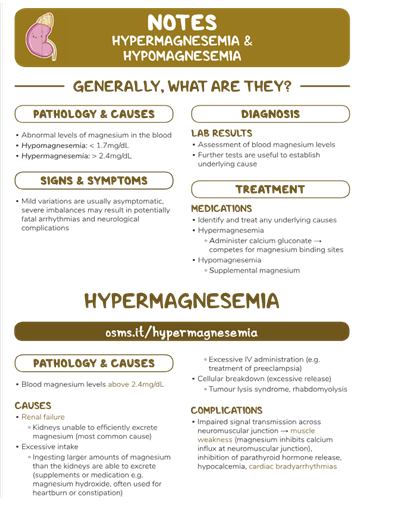A nurse is assessing a client who has hypermagnesemia. Which of the following medications should the nurse prepare to administer?
Calcium gluconate
Flumazenil
Acetylcysteine
Protamine sulfate
The Correct Answer is A
A. Calcium gluconate.
Hypermagnesemia refers to an abnormally high level of magnesium in the blood. High levels of magnesium can lead to muscle weakness, decreased reflexes, confusion, and other symptoms. One of the primary treatments for hypermagnesemia is administering calcium gluconate. Calcium gluconate is given intravenously and works by counteracting the effects of excess magnesium on muscles and nerves. It can help restore normal neuromuscular function and decrease symptoms associated with hypermagnesemia.
B. Flumazenil is used to reverse the effects of benzodiazepine overdose or excessive sedation. It has no direct effect on magnesium levels.
C. Acetylcysteine is used to treat acetaminophen (paracetamol) overdose and prevent liver damage. It is not related to treating hypermagnesemia.
D. Protamine sulfate is used to reverse the effects of heparin, a blood-thinning medication. It does not have a role in treating hypermagnesemia.

Nursing Test Bank
Naxlex Comprehensive Predictor Exams
Related Questions
Correct Answer is A
Explanation
A. Calcium gluconate.
Hypermagnesemia refers to an abnormally high level of magnesium in the blood. High levels of magnesium can lead to muscle weakness, decreased reflexes, confusion, and other symptoms. One of the primary treatments for hypermagnesemia is administering calcium gluconate. Calcium gluconate is given intravenously and works by counteracting the effects of excess magnesium on muscles and nerves. It can help restore normal neuromuscular function and decrease symptoms associated with hypermagnesemia.
B. Flumazenil is used to reverse the effects of benzodiazepine overdose or excessive sedation. It has no direct effect on magnesium levels.
C. Acetylcysteine is used to treat acetaminophen (paracetamol) overdose and prevent liver damage. It is not related to treating hypermagnesemia.
D. Protamine sulfate is used to reverse the effects of heparin, a blood-thinning medication. It does not have a role in treating hypermagnesemia.

Correct Answer is A
Explanation
A. Morphine 6 mg IV push every 3 hr PRN acute pain:
This choice is correct. It accurately transcribes the medication name (morphine), the dosage (6 mg), the route (IV push), the frequency (every 3 hours), and the indication (PRN for acute pain).
B. Morphine 6.0 mg IV push every 3 hr PRN acute pain:
This choice is not incorrect, but it is unnecessary to include the trailing zero in the dosage (6.0 mg). Both "6" and "6.0" indicate the same value, and omitting the decimal point is common practice in medication dosages.
C. MS 6 mg IV push every 3 hr PRN acute pain:
This choice is incorrect. "MS" is an abbreviation for "morphine sulfate," but it's not widely used in modern healthcare settings. Using the full name "morphine" is clearer and less prone to confusion.
D. MSO4 6 mg IV push every 3 hr PRN acute pain:
This choice is incorrect. "MSO4" is the chemical symbol for morphine sulfate. While it's a valid abbreviation, it's not as commonly used as the full name "morphine." Using the full name of the medication is clearer and more familiar to healthcare professionals.
Whether you are a student looking to ace your exams or a practicing nurse seeking to enhance your expertise , our nursing education contents will empower you with the confidence and competence to make a difference in the lives of patients and become a respected leader in the healthcare field.
Visit Naxlex, invest in your future and unlock endless possibilities with our unparalleled nursing education contents today
Report Wrong Answer on the Current Question
Do you disagree with the answer? If yes, what is your expected answer? Explain.
Kindly be descriptive with the issue you are facing.
